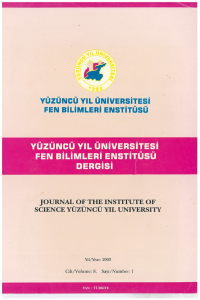The Transformation of Alkalo-to/erant Xylanase Gene from Bacillus sp. Origins to Gr (+) Bacteria by Using the Protoplast Transformation Method and Searching İts Expression Level
Öz
Alkalophilic Bacillus sp. isolation was made from the dry soil which was taken from the land around Van Gölü İn this research, Bacillus sp. X 151 strain was selected as the suitable strain among the isolations and its xylanase production was searched. From the point of view xylanase production, plasmid origiu was determined among the test strains. Result of this research alkalo tolerant and xylanase negative Bacillus cereus P 109 strain was determined as transformant strain.
The plasmid of alkalo-tolerant and xylanase pqsitive Bacillus sp. XI 5 i strain, was isolated by alkali lizis method. The plasmid was transfered to Bacillus cereus P 109 by protoplast transformation method. The seperation was made in agarose gel electrophoresis.
This study was considered to prove the isolation of alkalo-tolerant Bacillus sp., xylanase production in alkalo-tolerant Bacillus sp., their plasmid origin and the possibilities of gene transformation.
Anahtar Kelimeler
Alkalo-tolerant Bacillus sp. Xylanase Plasmid Protoplast Transformation
Kaynakça
- Ball, A.S., Me Charty, A.J., 1989. Production and Properties of Xylanases from Actimycetes. J. Appl. Bacteriology, (66): 439-444,
- Q.K., Kapoor, M., Mahajan, L., Hoondal, G.S., 2001. Microbial Xylanases and Their Industrial Applications: A review. Appl. Microbiol. Biotechnol, (56): 326-338.
- Calam, C.T., Daglish, L.B., McCann, E.P., 1976., Penicillum; Tactics In Strain Improvent. Jn Genetics of Industrial Microorganisms, Proceedings of Second International Svmposium On The Genetics of Industrial Microorganisms. Mac Donald (EO), Academic Press, 243-252s,
Protoplast Transformasyon Metodu Kullanılarak Alkalo-tolerant Bacillus sp. Ksilanaz Geninin Gr (+) Bakterilere Transferi ve Ekspresyon Düzeyinin Araştırılması
Öz
Bu çalışmada, Van gölü çevresindeki suyu çekilmiş alanlardan alınan toprak numunelerinden alkalo-tolemnt Bacillus sp izolasyonu yapıldı. İzolatlar arasından alkalo-tolerant Bacillus sp. XI 51 suşu çalışmanın amacına uygun suş olarak seçilerek ksilanaz üretimi araştırıldı. Test suşlannda ksilanaz prodüksiyonunun plasmit kökenli olup olmadığı belirlendi. Araştırma neticesinde, ksilanaz prodüksiyonu açısından negatif olan alkalo-tolerant Bacillus cereus Pİ 09 suşu ise trasforme olmaya yönelik alıcı suş olarak bulundu.
Ksilanaz pozitif afkalo-tolerant Bacillus sp. X 151 suşundan alkali lizi metoduyla plasmid izole edildi. Plasmit, protoplast transformasyon tekniği ile ksilanaz negatifBacillus cereus P 109 suşuna aktarıldı. Plasmid DNA agaroz jel elektroforezinde sepera edildi.
Bu çalışma, alkalo-tolerant özellikte olan Bacillus sp. izolasyonu, alkalo-to[erant Bacillus sp. suşlarında ksilanaz prodüksiyonu belirlenmesi, plasmit kökenli olup olmadığı ve gen aktarım olanaklarının araştırılması amacıyla ele alındı.
Anahtar Kelimeler
Alkalo-tolerant Bacillus sp Ksilanaz Plasmit Protoplast Transformasyonu
Kaynakça
- Ball, A.S., Me Charty, A.J., 1989. Production and Properties of Xylanases from Actimycetes. J. Appl. Bacteriology, (66): 439-444,
- Q.K., Kapoor, M., Mahajan, L., Hoondal, G.S., 2001. Microbial Xylanases and Their Industrial Applications: A review. Appl. Microbiol. Biotechnol, (56): 326-338.
- Calam, C.T., Daglish, L.B., McCann, E.P., 1976., Penicillum; Tactics In Strain Improvent. Jn Genetics of Industrial Microorganisms, Proceedings of Second International Svmposium On The Genetics of Industrial Microorganisms. Mac Donald (EO), Academic Press, 243-252s,
Ayrıntılar
| Birincil Dil | Türkçe |
|---|---|
| Bölüm | Makaleler |
| Yazarlar | |
| Yayımlanma Tarihi | 1 Ağustos 2003 |
| Gönderilme Tarihi | 1 Ağustos 2003 |
| Yayımlandığı Sayı | Yıl 2003 Cilt: 8 Sayı: 1 |


